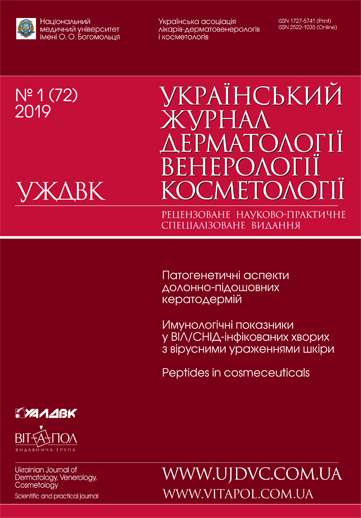Сучасний погляд на особливості топічної та комбінованої терапії хворих на оніхомікоз
DOI:
https://doi.org/10.30978/UJDVK2019-1-46Ключові слова:
оніхомікоз, топічна терапія, комбінована терапія, індивідуалізація програм лікування, циклопірокс 8 %, «Цикложен», індекси тяжкостіАнотація
Оніхомікоз є розповсюдженим захворюванням нігтьового апарату, що спричинюється дерматофітами, грибами-сапрофітами і дріжджами і становить до 50 % від усіх захворювань нігтів. Оніхомікоз тяжко піддається лікуванню через компактну структуру нігтьової пластини, повільний її ріст та наявність біоплівок, які діють в якості захисного бар’єра для мікроорганізмів та допомагають грибам адаптуватися до стресових ситуацій і можуть бути постійним джерелом інфекції. Необхідно використовувати індивідуальний підхід у лікуванні цього захворювання, враховуючи ступінь ураження нігтьових пластин та використовуючи індекси КІОТОС або індекс тяжкості оніхомікозу (OSI — Onychomycosis Severity Index). Залежно від ступеня тяжкості призначають або топічну, або системну терапію, або їх комбінацію, використовуючи переваги кожного методу лікування. Для ефективного проникнення в нігтьову пластину діючої речовини потрібен баланс між фізико-хімічними властивостями лікарського засобу та біофізичними характеристиками нігтьової пластини. Завдяки перевагам сучасних топічних протигрибкових препаратів у вигляді лаку, що поліпшують адгезію та проникнення діючої речовини крізь нігтьову пластину, можна покращити доступ лікарського засобу крізь нігтьовий бар’єр, розширити спектр протигрибкової дії, знизити навантаження системних антимікотичних препаратів на організм шляхом використання комбінованої терапії, яка за рахунок різних механізмів дії дає змогу скоротити тривалість лікування і зменшити кумулятивну дозу пероральних антимікотичних препаратів. Враховуючи відсутність резистентності до циклопіроксу, що доведено у багатьох дослідженнях, можливо довготривале використання цього препарату у складних випадках, які тяжко піддаються лікуванню, як протирецидивуючої терапії та як профілактичного засобу ураження нігтьових пластин грибковою інфекцією.Посилання
Kasikhina YeI Tsiklopiroks: klinicheskiy opyt i sovremennyye tendentsii v topicheskoy terapii onikhomikoza. Consilium Medicum. Dermatologiya (pril.). 2017;1:16-20 (Rus.).
Rikberg AB, Litus AI. Problema kompleksnogo primeneniya indeksov tyazhesti onikhomikozov. Dermatolog. 2015,1:40-45 (Rus.).
Sergeyev YuV, Mokina YeV, Sergeyev AYu, i dr. Mestnaya i kombinirovannaya terapiya onikhomikozov. Posobiye dlya vrachey. M Nats akad Nikol; 2013:8-40 (Rus.).
Sergeyev YuV, Savchenko NV, Sergeyev AYu, i dr. Vozmozhnosti i perspektivy mestnoy i kombinirovannoy terapii onikhomikozov. Immunopatol, Allergol, Infektol. 2012;3:73-80 (Rus.).
Sergeyev YuV, Shpigel’ BY, Sergeyev AYu. Farmakoterapiya mikozov. M. Meditsina dlya vsekh; 2004:200.
Ameen M, Lear JT, Madan V, et al. British Association of Dermatologists guidelines for the management of onychomycosis. Br J Dermatol. 2014;171(5):937-958. doi: 10.1111/bjd.13358.
Avner S, Nir N, Henri T. Combination of oral terbinafine and topical ciclopirox compared to oral terbinafine for the treatment of onychomycosis. J Dermatol Treat. 2005;16(5-6):327-330.
Baran R, Sigurgeirsson B, de Berker D. A multicentre, randomized, controlled study of the efficacy, safety and cost-effectiveness of a combination therapy with amorolfine nail lacquer and oral terbinafine compared with oral terbinafine alone for the treatment of onychomycosis with matrix involvement. Br J Dermatol. 2007;157(1):149-157. doi: 10.1111/j.1365-2133.2007.07974.x.
Christenson JK, Peterson GM, Naunton M, et al. Challenges and Opportunities in the Management of Onychomycosis. J Fungi (Basel). 2018;4 (3):E87. doi: 10.3390/jof4030087.
Ghelardi E, Celandroni F, Gueye SA, et al. Potential of Ergosterol Synthesis Inhibitors To Cause Resistance or Cross-Resistance in Trichophyton rubrum. Antimicrob. Agents Chemother. 2014;58 (5):2825-2829.
Gupchup GV, Zatz JL Structural characteristics and permeability properties of the human nail. A review Journal of the Society of Cosmetic Chemists. 1999;50:363-385.
Gupta AK. Onychomycosis Combination Therapy Study Group. Ciclopirox topical solution, 8 % combined with oral terbinafine to treat onychomycosis: a randomized, evaluator-blinded study. J Drugs Dermatol. 2005;4(4):481-485. PMID:16004022.
Gupta AK, Baran R. Ciclopirox nail lacquer solution 8 % in the 21st century. J Am Acad Dermatol. 2000;43(4):96-102.
Gupta AK, Cernea M, Foley KA. Improving curerates in onychomycosis. J Cutan Med Surg. 2016;20:517-531.
Gupta AK, Daigle D, Carviel JL. The role of biofilms in onychomycosis. J Am Acad Dermatol. 2016;74:1241-1246. doi: 10.1016/j.jaad.2016.01.008.
Kasihina EI. Cyclopirox: clinical experience and current trends in the topical treatment of onychomycosis. Consilium Medicum. Dermatology (Suppl.). 2017;1:16-20.
Kataria P, Sharma G, Thakur K, et al. Emergence of nail lacquers as potential transungual delivery system in the management of onchomycosis. Expert Opin Drug Deliv. 2016;13(7):937-952. doi: 10.1080/17425247. 2016.1174691.
Kreijkamp-Kaspers S, Hawke K, Guo L, et al. Oral antifungal medication for toenail onychomycosis. Cochrane Database Syst Rev. 2017;7:Cd010031.
Murdan S. Enhancing the nail permeability of topically applied drugs. Expert Opin Drug Deliv. 2008;5:1267-1282.
Niewerth M, Kunze D, Seibold M, et al. Ciclopirox Olamine Treatment Affects the Expression Pattern of Candida albicans Genes Encoding Virulence Factors, Iron Metabolism Proteins, and Drug Resistance Factors. Antimicrob. Agents Chemother. 2003;47(6):1805-1817.
Rubrum T, Ghelardi E, Celandroni F, et al. Potential of Ergosterol Synthesis Inhibitors To Cause Resistance or Cross-Resistance in Trichophyton rubrum. Antimicrob Agents Chemother. 2014;58(5):2825-2829.
Schaller M, Borelli C, Berger U, et al. Susceptibility testing of amorolfine, bifonazole and ciclopiroxolamine against Trichophyton rubrum in an in vitro model of dermatophyte nail infection. Med Mycol. 2009;47:753-758.
Shen T, Huang S. Repositioning the Old Fungicide Ciclopirox for New Medical Uses. Cur Pharm Des. 2016;22(28):4443-4450.
Tabara K, Szewczyk AE, Bienias W, et al. Amorolfinevs, ciclopirox - lacquers for the treatmentof onychomycosis. Postepy Dermatol Alergol. 2015;32(1):40-45. doi: 10.5114/pdia.2014.40968.
Tatsumi Y, Yokoo M, Senda H, Kakehi K. Therapeutic efficacy of topically applied KP‑103 against experimental tinea unguium in guinea pigs in comparison with amorolfine and terbinafine. Antimicrob. Agents Chemother. 2002;46(12):3797-3801.
Tosti A, Elewski BE. Onychomycosis: Practical approaches to minimize relapse and recurrence. Skin Appendage Disord. 2016;2(1-2):83-87. doi: 10.1159/000448056.





